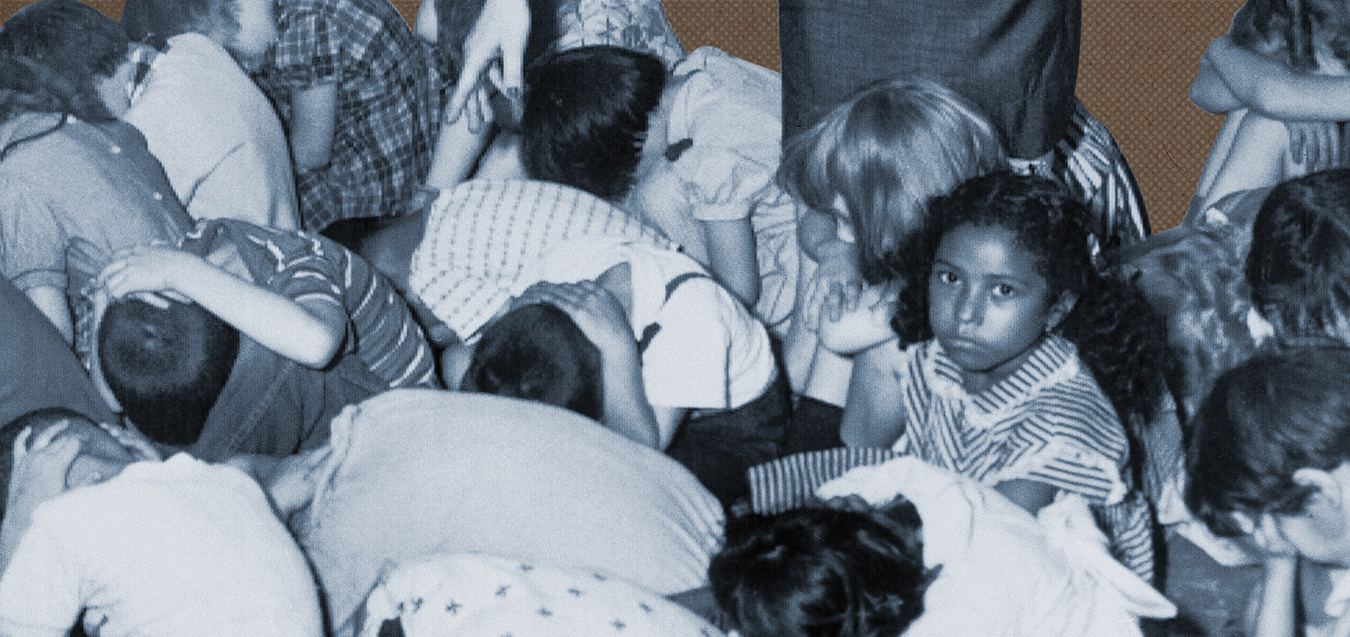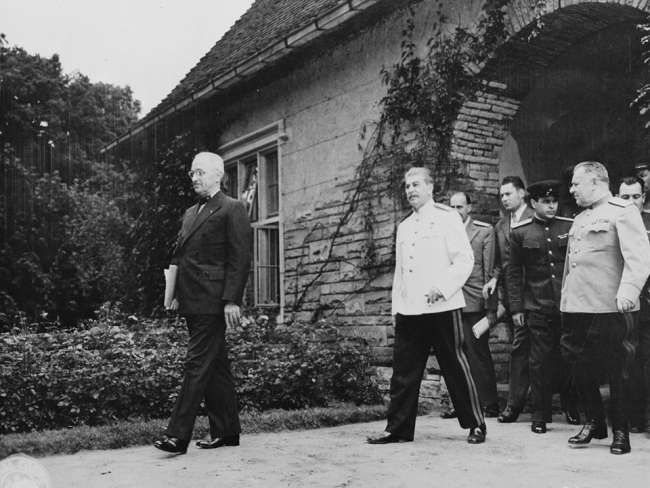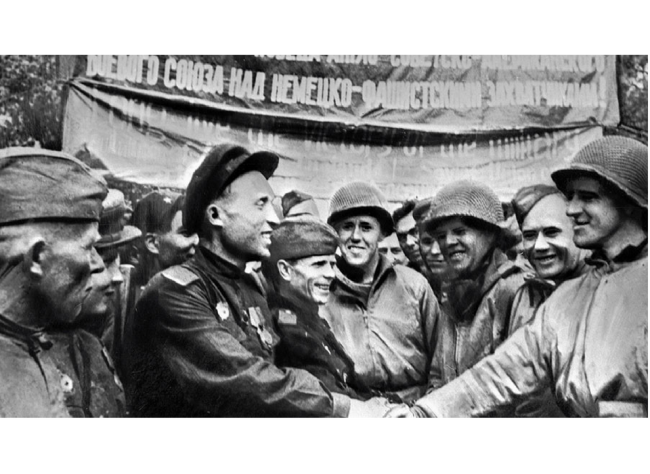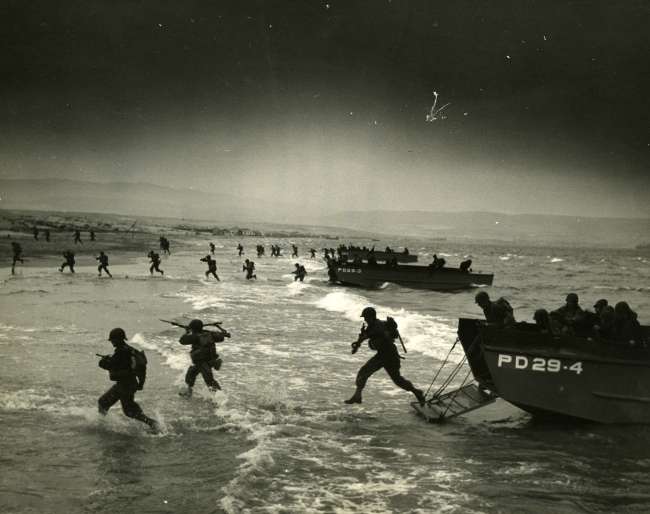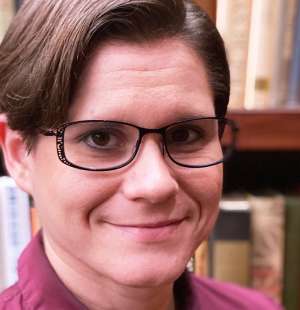Listen: Apple Podcasts, Spotify.
About the Episode
The escalating competition between the United States and the Soviet Union for global domination set a new tone that came to influence relations at home and abroad for the remainder of the twentieth century. Tensions that had been building throughout World War II eventually turned former allies into enemies as Stalin’s Iron Curtain fell across eastern Europe. Concerns over continued Soviet expansion led to the establishment of new approaches to foreign policy that centered on containing the spread of communism. Truman established the US as the leading force in preventing more countries from falling to communism, and Americans began to live with the prospect that another war might begin. This war, however, came with a new, fearful weapon: the atomic bomb.
This week’s episode, written and hosted by the Museum’s Dr. Kristen Burton, explores the spreading fear that came to inform life across the United States, as neighbors grew weary of neighbors, and once innocuous activities took on new sinister meanings. For the second time, the US experienced a Red Scare, and citizens increasingly fell under suspicion of having sympathies for communism or the USSR. Investigations that targeted artists and writers spawned a new era of interrogation and suppression. Homes began to feature fallout shelters to protect against an anticipated nuclear attack. Life in the atomic age maintained a sinister edge for the rest of the century, as movies produced throughout the era captured the fear and mania of the Cold War, and school children across the US learned how to ‘duck and cover’ should they see the flash from a detonating atomic bomb.
New episodes are released every other Friday. Catch up on all episodes of “To the Best of My Ability” and be sure to leave us a review on your favorite podcast platform.
Topics Covered in this Episode
- Start of the Cold War
- The Second Red Scare
- Fear of Communism and atomic warfare in post-war United States
- Joseph McCarthy (McCarthyism) and the House Un-American Activities Committee (HUAC)
- The Hollywood Blacklist
- Bert the Turtle
Featured Historian
Dr. Rob Citino
Dr. Rob Citino is Samuel Zemurray Stone Senior Historian in the Institute for the Study of War and Democracy at The National WWII Museum. Citino is an award-winning military historian and scholar who has published 10 books including The Wehrmacht Retreats: Fighting a Lost War, 1943, Death of the Wehrmacht: The German Campaigns of 1942, and The German Way of War: From the Thirty Years’ War to the Third Reich and numerous articles covering World War II and 20th century military history.
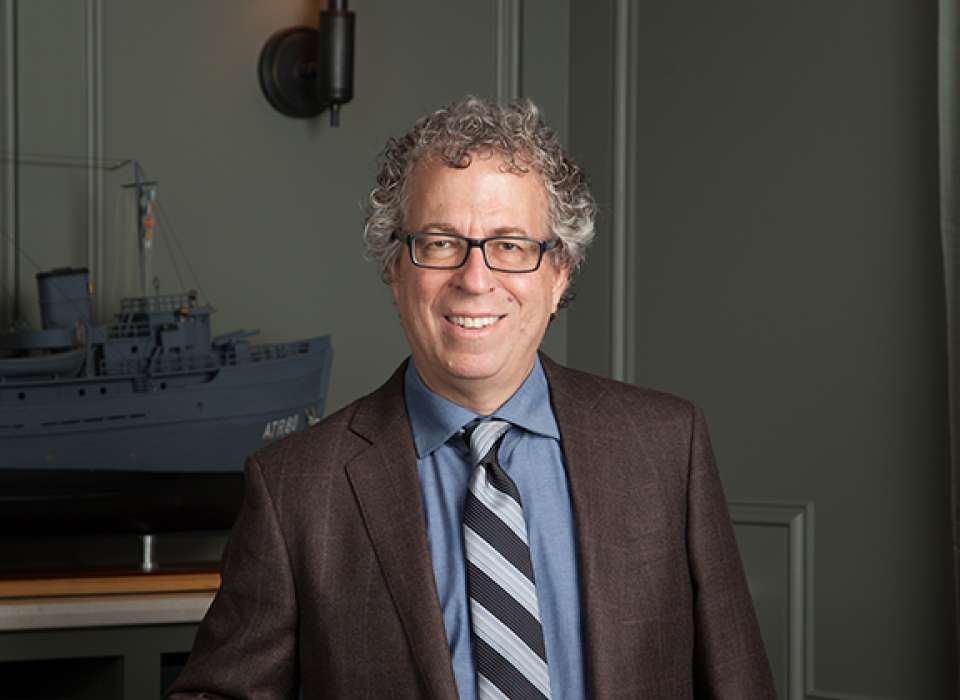
Related Content
-
Article Type
Cold Conflict
The United States was not the only leading power on the world stage after the end of World War II; it had a new competitor for this power in the Soviet Union. Tensions between the former allies quickly grew, leading to a new kind of conflict—one heightened with the threat of atomic weapons—that came to dominate global politics for the remainder of the twentieth century.
-
-
Arizona State University Partnership
The National WWII Museum and Arizona State University's School of Historical, Philosophical, and Religious Studies of... -
Contributor
Kristen D. Burton, PhD
Kristen D. Burton is the Teacher Programs and Curriculum Specialist at The National WWII Museum in New Orleans, LA.
Sponsors
"To the Best of My Ability" is part of an ongoing series commemorating the 75th Anniversary of the End of World War II made possible by The Nierenberg Family.
Transcript
Archival Audio - Universal Newsreel
[J. Edgar Hoover speaking]
The Communist Party of the United States is a fifth column if there ever was one. It is far better organized than were the Nazis in occupied countries prior to their capitulation. They are seeking to weaken America, just as they did in their era of obstruction when they were aligned with the Nazis. Their goal is the overthrow of our government. There is no doubt as to where a real communist’s loyalty rests. Their allegiance is to Russia, not the United States. Communism in reality is not a political party. It is a way of life - an evil and malignant way of life. It reveals a condition akin to disease. It spreads like an epidemic, and like an epidemic, a quarantine is necessary to keep it from infecting this nation.
Dr. Kristen Burton
Long-building tensions between the US and USSR eventually came to a head in the aftermath of WWII, as both nations emerged from the war as the two leading powers on the globe. With Germany’s defeat, the alliance holding the United States and Soviet Russia together gave way to an ideological rivalry that came to dominate life in the post-war world. What came to be known as the “Cold War,” as tensions never gave way to direct military conflict between the two powers, led to increasing anxiety and a feeling of paranoia, both at home and abroad. With the US briefly standing as the only power with atomic weapons, maintenance of the global order fell to Truman, all while the Soviets engaged in their own race for military superiority. The building contest for domination came to spark an era of suspicion that placed neighbor against neighbor, heightened by a growing and constant fear of a possible nuclear war.
Archival Audio - Truman Taking the Oath of Office
“I Harry S. Truman do solemnly swear to faithfully execute the Office of President of the United States, and will to the best of my ability, preserve, protect and defend the Constitution of the United States, so help me God.”
Dr. Kristen Burton
You’re listening to “To the Best of My Ability: The Postwar Years” from The National WWII Museum in New Orleans. This is episode 4, “Duck and Cover.” I’m your host, Dr. Kristen Burton. This week we travel to the Pacific, to an atoll in the Marshall Islands, where post-war tests of nuclear weaponry are underway.
Archival Audio - Newsreel: Atomic Age
[Reporter speaking]
Man’s destiny ticks away to the sound of a metronome on the deck of the battleship Pennsylvania in Bikini Lagoon. This is the first peace-time test of atomic energy, and to give you a true picture of its importance we bring you the member of Parliament who has made it his special study, Raymond Blackburn. [Blackburn speaking]: “The American bomber starts on its mission over Bikini. Eight months before such a plane took off, it was on the glorious morning in August 1945. Then, the atom bomb it carried killed 80,000 people at Hiroshima. That time, there was no warning. The only accessors of the terrible effect of the bomb were the men and women who survived. This time, the crews of waiting ships who prepared to meet the blinding glare of the explosion, know that only goats and other animals can be the victims. Meantime, as zero hour approached, the world waited. The last few moments, the metronome on board the Pennsylvania ticks away the final seconds heard throughout the world.”
Dr. Kristen Burton
Joining us this week to discuss the growing threat of communist Russia and Truman’s response to the emerging conflict that became the Cold War is Dr. Rob Citino, Samuel Zemurray Stone Senior Historian at the Institute for the Study of War and Democracy at The National WWII Museum.
Dr. Rob Citino
That's the interesting thing about Truman's foreign policy. It's a complete break with FDR’s. FDR had been in office for as long as just about anyone could remember. He's built a foreign policy, at least a wartime foreign policy, around accommodation with Stalin, at the very least, not picking fights with them, realizing that Stalin had more troops in the field against Germany than any other of the allies, more than all of them put together, and that—he had no choice but to work with Stalin. By the time Truman comes into the Oval Office, it's pretty clear the war against Germany has been won. He feels it's time to stop coddling the Soviets—and his famous phrase, you know, “it's time to stop babying them.” This is about power politics now and about who is going to be jockeying and maneuvering for position in the postwar world.
From the beginning of his presidency, he's doing amazing things like calling in Soviet Foreign Minister Molotov into the Oval Office and kind of reading him the Riot Act about Soviet failure to live up to the problems with regards to the occupied territories.
Dr. Kristen Burton
As the United States took on a dominant role in helping to rebuild regions devastated by WWII, a new sense of responsibility came to define the power and influence America now carried on the world stage. Through the European Recovery Plan, the US dedicated over $13 billion to rebuild Western Europe through the Marshall Plan. Unlike the move toward isolationism that followed WWI, the United States came out of WWII as a commanding power that had every intention to remain engaged in world affairs. Still, rebuilding war-torn Europe depended on important alliances, and initially, the Allied powers took on a collective role in this process. However, not all of the Allies had the means to take on leading roles, as the war had decimated resources and supplies in both Britain and France. While nations that once held great power before the war came through to the other side depleted and in need of support, the United States and Soviet Russia emerged stronger than ever. Both countries also found themselves in a unique position as they held the ability to influence and direct the order of governance and life the world over.
What would this post-war world look like? And who, ultimately, would win the race for global domination?
Dr. Rob Citino
It took the entire globe banding together to defeat the Germans and, on the side, the Japanese. But in the end of the war, you only have two great powers, and they're so powerful that we had to think up a new word for them. And superpower was the term that now began to be used. But by definition, this was a bipolar world. There were only two big powers, and they had global claims. And so, any conflict that broke out anywhere could theoretically result in a Third World War. And if the Soviets are going to develop atomic weaponry, that's going to become even more terrifying. So you have a much more unstable situation. Now, at first, the Americans and the Soviets tried to get along. They at least made a show of getting along. A lot of people don't realize this, but there were plans for a semi-regular congress of foreign ministers in which the Soviet and the American officials would meet with their allies on both sides and discuss issues of the day, you know, to try to keep the peace, to try to make sure that the situation never got out of hand.
Dr. Kristen Burton
Before his death, President Roosevelt hoped to see a lasting peace follow the end of the war, but relations with the Soviet Union, and the actions of Joseph Stalin, complicated that vision. The USSR’s quick move to claim territory in Europe following Germany’s defeat appeared to Truman as a clear grab for power that would give the Soviet Union increasing control over global affairs. Within months of the war’s end, it became evident that Stalin would not keep the promises he made at the Yalta Conference in February 1945, in which he called for the creation of “interim governmental authorities broadly representative of all democratic elements in the population” in the territories liberated of Nazi rule. Stalin also called for the earliest possible establishment of “free elections of governments responsive to the will of the people.”
However, by 1946, free elections and representative governments did not emerge in Soviet-controlled Poland, Czechoslovakia, Hungary, Romania, or Bulgaria. Communist governments were instead installed, and all political dissidents were forcibly removed from power. This action in Eastern Europe showed the US and other western nations what would follow should the USSR continue to spread its power and influence into other regions across the globe. This pushed the US to adopt a new approach to its foreign policy in 1947; an approach known as “containment.”
Dr. Rob Citino
Let me explain containment by perhaps explaining its opposite, and it's something called rollback. You don't like the Soviet gains in Eastern Europe after the war. You don't like the fact that part of Germany is under Soviet occupation, the German Democratic Republic, it will eventually be called, our East Germany. You don't like the fact that the Soviets have set up communist states. You don't like the Iron Curtain. So you plan a strategy to roll it back, to push the Soviets back. Now, the only trouble is if you really are dedicated to rollback, you're probably talking about World War III. So the alternate strategy is something called containment. The Soviets are where they are, and for now, there's no real chance of pushing them back, but you want them to stay where they are. You don't want them making any further advances.
Dr. Kristen Burton
The instability that followed the end of the war forced a global realignment of the balance of power. Before WWII, Great Britain traditionally took charge of dealing with unrest in certain regions of the world, but after the war, Britain lost the ability to exert its influence abroad in the same manner. In March 1947, British envoys sent to Washington notified Truman that Britain could no longer be responsible for maintaining stability in the Near East or in the Mediterranean. This notice came as communist uprisings in Greece led to civil war between the Greek national government and the Greek Communist Party. Simultaneously, Soviet forces began to pressure Turkey, which had also been dependent on British aid. These two crises collectively pushed Truman to call on the US Congress to send $400,000 in aid to both the Greek and Turkish governments, in a move that would define a defensive form of foreign policy in which the United States would no longer stand by as the Soviet Union engaged in forcible expansion. Deemed the Truman Doctrine, it became the official policy of the United States “to support free peoples who are resisting attempted subjugation by armed minorities or by outside pressures.”
Archival Audio - Newsreel: Truman’s Speech, “A Fateful Hour”
[Reporter] Before America’s Congress, President Truman makes the most momentous speech since the death of Franklin Roosevelt. He declares political war on Soviet Russia. In American eyes, Britain is no longer the bulwark against communist expansion. [Truman speaking]: “Great Britain finds itself under the necessity of reducing or liquidating its commitments in several parts of the world, including Greece. As in the case of Greece, if Turkey is to have the assistance it needs, the United States must supply it. We are the only country able to provide that help.”
[Reporter] From now on, it means that anti-communist America will make its influence felt in European affairs. [Truman speaking]: “If we falter in our leadership, we may endanger the peace of the world, and we shall surely endanger the welfare of this nation. Great responsibilities have been placed upon us by the swift movement of events. I am confident that the Congress will face these responsibilities squarely.
[Reporter] Truman points the way to a new foreign policy. Timed to coincide with the sitting of the Moscow Conference, the speech means that the United States now faces up to its international responsibilities. America has decided that her true frontiers are in Europe.
[Applause]
Dr. Kristen Burton
While taking a leading role in containing the spread of communism, the United States would not stand alone against Soviet expansionism due to newly formed alliances established as tensions with the USSR continued to mount.
Dr. Rob Citino
We established NATO, the North Atlantic Treaty Organization, in the late 1940s. And this signed up all the powers in Western Europe into a mutual defense act against any kind of Soviet aggression. There's a clause in the NATO treaty to this day that an attack on any of the signatories to the treaty is an attack on everybody and everybody who had signed the treaty will come to your aid. So it's not all about America pushing people around. It's about signing up allies and realizing that we're all in this together. But, you know, it's not even strictly about the military side or about hard power. There's also a softer form of US power, and that's the almighty dollar. I'm thinking here of the Marshall Plan in which we gave hundreds of millions of dollars to our allies and former adversaries alike.
When you say Marshall Plan, you technically mean Europe, the European recovery plan, but we also gave hundreds of millions of dollars to Japan in the Pacific as well for rebuilding purposes. And the point here was that why? Why does a communist insurgency build up inside a country? Is the economy in the tank? Is wealth so unfairly distributed that some people live in mansions on a hill while the vast majority of the population is starving in the streets? I mean, US policymakers took a pretty good look at this. So, look, the Marshall Plan is not strictly charity. We knew we had to have functioning trade partners abroad or our economy would go into the tank along with the rest of the world. So there's hardheaded diplomatic reasons to give this money away, but it's always tough to give money away. You have to go to the American people and explain why you're doing it. And policymakers at the time—and I'm thinking of our secretary of state George Marshall, the great chief of staff of the US Army during the war. We're willing to do just that.
Dr. Kristen Burton
As Truman directed new foreign policy to keep Soviet communism in check in faraway regions, a growing fear began to creep across the United States itself; a fear that America may also be vulnerable to communist infiltration. Paranoia of potential spies or Soviet subversives spread across communities, as neighbors began to suspect one another, and certain activities appeared to take on new, sinister meanings.
The social and economic unrest that followed the end of WWII fed into this growing fear of communism. In 1946, a massive wave of labor strikes began to spread across the country, making unions an easy target for accusations of communist affiliation. Along with US workers going on strike for better pay and safer working conditions, social activists also faced similar attacks and charges of communist sympathies. Specifically, black activists who had been pushing for the repeal of suppressive Jim Crow and segregationist laws, fell under suspicion. In 1947, Attorney General, Tom C. Clark, created a list of “subversive organizations,” and included the National Negro Congress, as well as the Council on African Affairs. That same year, Life magazine published an article that claimed the NAACP was under communist influence. Segregationists who sought to preserve white supremacy used the fear of communism to cut efforts for black equality off at the knees.
J. Edgar Hoover pushed for an expansion of the FBI, which doubled in size in order to hunt for suspected communists. In the frenzy that followed, even activists who had been personal friends of the Roosevelts, such as Mary MacLeod Bethune, were subject to FBI investigation. The prolific author, activist, and sociologist, W.E.B. Du Bois was put on trial in 1951 at the age of 83 when his work with the anti-nuclear weapon organization, Peace Information Center, caused the Justice Department to charge Du Bois with acting as an agent for a foreign state.
Dr. Rob Citino
So we usually think of the Cold War as this big diplomatic and military encounter between the United States and the Soviet Union, but it had its domestic side as well, especially inside the United States. It's the era of the Red Scare, of this notion that subversives are at work everywhere in the American society, your neighbor, your kid's teacher, the old man down the street who's working his ham radio in the basement. Who's he talking to at night? There was a real paranoia, a real fear. It's funny. America has tended to wall itself off from the rest of the world. You know, we talk about isolationism. And while isolationism isn't a factor, Americans still really don't see themselves very often as open to trends outside the country. And it had happened after World War I. We briefly opened ourselves to the world and there was a red scare then, too, after the Soviet revolution in Russia. And it happens again in the late 40s and early 1950s.
Dr. Kristen Burton
Coinciding with Truman’s shift in foreign policy, he also issued Executive Order 9835 on March 21, 1947. This order required all federal civil-service employees to pledge their loyalty to the United States. Signs of disloyalty included “membership in, affiliation with or a sympathetic association” with “totalitarian, facist, communist or subversive” organizations. This provided a basis of what would become the second Red Scare in US history. Fears of espionage and governmental infiltration fed into the larger, growing paranoia across American society. The discovery of Soviet spies, such as Klaus Fuchs, who worked on the Manhattan Project and funneled information on building atomic bombs to the USSR validated these public fears, and an increasing number of American citizens fell under intense suspicion and interrogation.
The House Un-American Activities Committee (HUAC), which was originally formed in 1938, became a permanent committee in 1945, and following Truman’s executive order took on a leading role in investigating real and suspected communists embedded within the United States. Beginning in 1947, the committee began nine days of hearings into alleged communist activity within Hollywood and the motion picture industry. When ten directors, screenwriters, and producers were found to be in contempt for refusing to answer the committee’s questions, they were placed on a blacklist and barred from openly working in the industry. Along with the initial “Hollywood Ten,” over 300 artists would find themselves stained with being a suspected communist, leading to ruined careers, and ruined lives.
Dr. Rob Citino
There's a politician who has to be name-checked here. He’s Senator Joseph McCarthy, a Republican from Wisconsin. But, you know, I've always thought that McCarthy, as obnoxious as he was—and frankly, I think un-American and his own views, suspicious and paranoid of everyone, and making people defend themselves who had no reason even to be thrust into that position. I think he was more a symptom rather than a cause of the Red Scare. I think the paranoia and fear of the American people—the Soviets are on the move. This is the new age of nuclear weapons. They don't have one yet, but they're about to get one in the late 1940s. And I think you put all these things together and you get a character like Joseph McCarthy. He runs for the Senate against the Liberal-Republican Senator LaFollette in Wisconsin in 1946 and then wins that year. It takes him a while to really understand the mood of the nation, but he is a demagogue and a very ambitious one. And it's suddenly, you know, in 1950, that he drops a bombshell on people when he says that he has the—what does he say? I have a list of members of the Communist Party and subversives within the State Department. So it's a bad time. And you know that McCarthy accuses people in all sorts of industries of being disloyal to the country. Perhaps the most famous is the Hollywood blacklist, you know, lots of very, very creative people. People that had really done good work in the United States had to leave the country to find what they felt was a more open mood, a mood where you could experiment and be more progressive.
You know, there's nothing here that equates anywhere close to the situation in the Soviet Union where tens of thousands of people and more than that, perhaps hundreds of thousands, millions, were either killed or jailed for years and sometimes for life. But, you know, whenever people say, “Well, we weren't as bad as the Soviet Union,” I just respond, “That's a low bar.” Nobody should be comparing themselves to Stalinist Russia and patting themselves on the back because they weren't that bad. The McCarthy era was a kind of low point in American history as far as I'm concerned.
Dr. Kristen Burton
Fear of communism, as well as the possibility of nuclear war, only increased in 1949, when, on August 29, the USSR successfully tested its own atomic bomb. The United States no longer held this unique military advantage, and the prospect of direct conflict with the Soviet Union would define life throughout much of the remaining decades in the twentieth century. That same year, the victory of communist forces in China, and the fall of a former US ally during WWII, struck an ominous chord for life in this new atomic age.
Americans prepared for the possibility of another world war, but one fought with atomic bombs rather than traditional ones, by building fallout shelters, or enclosed structures designed to protect those inside from radioactive debris. Truman called for the creation of the Federal Civil Defense Administration in 1950, and this agency helped prepare the American public for a future nuclear war. The agency published materials to aid in civil defense, including guides on constructing a fallout shelter for the home, and also issued training films sent to schools across the United States. In one film, the agency directed school children to follow the lead of a cartoon turtle named Bert, who - when he saw a bright flash or heard a loud bang - would duck and cover into his shell.
Archival Audio - “Duck and Cover” film
Hey Bert, come out here and meet all these nice people, please? Oh, all right. We really can’t blame you. You see, Bert is a very, very careful fellow. When there’s danger, this is the way he keeps from being hurt. Sometimes, it even saves his life. That’s why these children are practicing to duck and cover, just as you do in your school. We all know the atomic bomb is very dangerous, and since it may be used against us we must get ready for it, just as we are ready for many other dangers around us all the time. Fire is a danger. It can burn whole buildings if someone is careless. But we are ready for fires. We have a fine fire department to put out the fire, and you have fire drills in your school so you know what to do. Automobiles can be dangerous, too. They sometimes cause bad accidents, but we are ready. We have safety rules that car drivers and people who are walking obey. Now, we must ready for a new danger, the atomic bomb.
Dr. Kristen Burton
The threat of nuclear war came to permeate all aspects of life in the post-war United States. As homes came to feature fallout shelters and school children participated in drills to prepare for a possible attack, American culture began to reflect the anxiety of life in the atomic age in both films and literature. Movies, such as My Son John, starred Robert Walker as a suspected Communist spy. Stanley Kubrick’s famous dark comedy, Dr. Strangelove, captured the mania surrounding the growing nuclear arms race between the US and USSR through scathing satire. Arthur Miller also responded to the rampant fear of the Red Scare in his play The Crucible, as he drew connections between the hunt for communists in the 1950s to the Salem witchcraft trials of 1692.
The Atomic Age and fear of Soviet infiltration led to an era of conformity, as fewer Americans sought to risk the possibility of suspected subversion. However, with the rampant accusations, fed by a growing hysteria, the hunt for communists would eventually falter. McCarthy’s continued claims of inside knowledge ultimately proved to offer no useful information, and by the mid-1950s his rise to power began to slide. The HUAC similarity lost prestige throughout the decade, causing Truman to denounce the committee in 1959 as “the most un-American thing in the country today.”
In spite of the dwindling Red Scare, the fear of communism persisted, and the threat of nuclear war only grew as proxy wars fought as a result of Containment led to increased tensions. Fear of nuclear war continued throughout the twentieth century, as school children living in the 1980s - and briefly into the 1990s - continued to learn the timeless lesson from Bert the Turtle to duck and cover.
Archival Audio - “Duck and Cover”
Dum dum, deedle-dum dum
Deedle-dum dum, deedle-dum dum
There was a turtle by the name of Bert
And Bert the turtle was very alert
When danger threatened him, he never got hurt
He knew just what to do...
(bang) He'd duck! (gasp) And cover!
Duck! (gasp) And cover!
He did what we all must learn to do
You, and you, and you, and you
(bang) Duck! (gasp) And cover!
Dr. Kristen Burton
In our next episode, “Strike Wave,” a series of large-scale post-war labor strikes, spanning numerous industries and public utilities, spread across the United States from 1945-1946, and involved over 5 million Americans. Demanding better safety regulations and better pay, this wave of labor strikes would permanently reshape the operation and structure of labor unions in the United States.
From The National WWII Museum, I’m Dr. Kristen Burton. This episode was written by me, Dr. Kristen Burton. Media production manager Jeremy Burson did the sound mixing. Archival audio is courtesy of the Screen Gems Collection at the Harry S. Truman Library, British Pathé, and Universal Newsreels held by the National Archives.
If you like this podcast, please rate and review us on Apple Podcasts, which helps others to find the series. "To the Best of My Ability" is part of an ongoing series of programs commemorating the 75th Anniversary of the End of World War II made possible by The Nierenberg Family.
